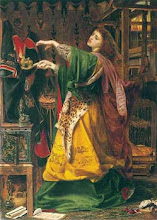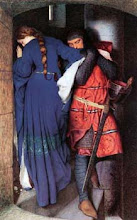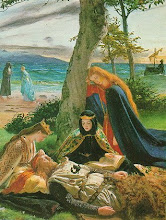August 13, 2005
The man who invented Arthur
His legends of Lancelot, Guinevere and Galahad are embedded in our national psyche. But who was Thomas Malory? Peter Ackroyd considers the enigmatic figure who penned the greatest epic tale of English chivalry
GREAT NATIONAL EPICS HANG, like Muhammad’s tomb, somewhere suspended between heaven and earth. They seem to have reached beyond the range of time and circumstance, and their supposed authors seem beyond the reach of posterity. Nobody knows who “wrote” the Nibelungenlied, and the identity of Homer is forever in question. The same obscurity has descended upon Sir Thomas Malory, who has been credited with the composition of what Christina Hardyment in this enterprising biography calls “our most enduring national epic”. It is known as Le Morte Darthur and, although it is in many respects an epic made out of other epics, it is a work that has effectively created the myth of Arthur and his knights for all subsequent generations.
As a result of Malory’s plangent and often elaborate prose, the song of Arthur has never ended. He inspired Milton and Dryden with dreams of Arthurian epic, and in the 19th century it was predominantly Tennyson who restored the themes of Malory to life with The Idylls of the King. William Morris wrote The Defence of Guenevere, and Swinburne composed Tristram of Lyonesse. The Round Table had been reconstituted in the libraries of 19th-century England.
It was Malory, too, who created for posterity the images of Lancelot and of Guinevere, of Tristram and Isolde, of Galahad and Gawain, of Merlin the magician and Arthur the once and future king. Never has so elusive and fugitive an author created so triumphant a mythology. So in proportion to the grand and gleaming giants of his imagination, Malory has retreated into the shadows. He was not formally named until the end of the 19th century, when an American scholar identified him as Sir Thomas Malory of Newbold Revel. There were other Thomas Malorys of the period — Malory died in 1471 — but this particular assignation seems to have stuck.
It seems to have been something of a baptism of fire, however. Almost as soon as he was named, he was blamed for various heinous crimes. At the beginning of the 20th century another American scholar discovered a court record, partially burnt, that accused Malory of rape, ambush, intent to kill, theft, extortion and gang violence (the latter as the result of a raid upon a neighbouring abbey). He was by no means the model of medieval chivalry, and far from being the “very perfect gentle knight” of Chaucer’s Canterbury Tales. This one was a rogue and villain, violent and dangerous even by the lax standards of the 15th century.
Hardyment supposes that such a record might be incompatible with the wonderful achievement of Le Morte Darthur — which is why she goes to some length in order to exonerate him — but there is no necessary disjunction. Chaucer was also accused of rape (in the convoluted procedures of medieval law, “rape” did not necessarily mean rape in the modern sense), and Ben Jonson was a murderer. There is no connection between a vital prose and a virtuous life.
Yet in Hardyment’s account it would seem that Malory’s crimes were those of an enthusiast and a partisan, rather than a criminal. His actions were determined by his attachment to a code of chivalry that was even then being undermined by Parliament and by over-mighty lords. Sometimes he bears a passing resemblance to that other knight, Don Quixote, forever going to war on behalf of lost causes.
He was born at a difficult time, in the immediate aftermath of the unhappy reign of Richard II; that most theatrical of monarchs was struck down by the aspiring Henry IV in 1400. The murder of the King inaugurated a century of civil conflict in which Malory would play a large part. He came from a family steeped in the traditions of chivalry; they were “gentlemen that bear olde arms”, and had managed to acquire vast estates throughout Warwickshire. As such they were ineluctably drawn into the conflicts of the wider world.
Thomas Malory’s own father, John Malory, was imprisoned for a plot to seize the new King, Henry IV, but somehow he survived the King’s displeasure to lead forces against the King’s enemies. In this period the young Malory would have heard readings of the 12th-century Roman de Brut and the Morte Arthure, those clarion calls to the spirit of the chivalric age. It is also inevitable that he attended jousts and tournaments, where the words on the page took on a formidable and glorious life.
There is no doubt that he was formally trained in the arts of chivalry — arts that included hunting, riding, hawking and archery. His earliest biographer, writing in the 16th century, described him as “outstanding from his youth for his heroic spirit and many remarkable gifts”. At the age of 14 he went to war against France in the retinue of the Earl of Warwick. He served as a “lance” at Calais, and four years later he is mentioned in a “muster roll ” at Normandy.
Hardyment then goes on to posit that he spent the next two decades, the 1420s and the 1430s, as a foreign settler in France. This would at least help to explain his wide knowledge, and use, of French Romance literature in his masterwork. She also suggests that he was engaged with the Knights Hospitaller in the defence of Rhodes against the Turks in 1435, which would also account for his detailed knowledge of European travelling routes shown in Le Morte Darthur.
This must all remain conjecture. There are not many ascertainable facts to be gleaned by even the most assiduous of biographers; but they are at least sufficient to provide a living context for what is in part a military history of the early 15th century. There could be no more appropriate setting, in any case, for Le Morte Darthur itself. In part the great epic can be read as a magnificent retrieval of the exploits of the Lancastrian army in a foreign land. Hardyment is excellent, too, at recovering the stray details that make up the life of the design. The inclusion of specific names and places, for example, is generally a sure guide to the author’s real interests. Malory introduces on two occasions the name of Sir Sontraille, an obscure French captain who happened to be held captive in Warwickshire for ransom in 1432.
By 1441 Malory had become a knight, no doubt at the behest of the young Henry VI. He also became justice of the peace, Member of Parliament and Sheriff of Warwickshire. Hardyment describes him as “a wealthy and travelled man with a keen interest in new cultural developments”. The house at Newbold Revel was enlarged, no doubt because he was in the process of acquiring a wife and family. He had a large household of servants, including a harper whose duty was to sing of love and chivalry. Malory probably had a collection of books as well, and Hardyment reconstructs a library containing, among other volumes, Ywain and Gawain — an English translation and adaptation of Chrétien de Troyes’ Le Chevalier au Lion — Chaucer’s Troilus and Criseyde, Vegetius’s 4th-century Art of War and the New Testament.
A library can be a refuge as well as an inspiration. This was a time of weak governance in England, with the retinues of over-mighty nobles vying for ascendancy under the titular dominance of the feeble, amiable and religiose Henry VI. France was all but lost. A rebellion against the lawful authorities was raised by Jack Cade. And in this period Malory, with 26 others, was accused of ambushing the Duke of Buckingham with intent to murder him. The escapade was in fact part of the internecine conflicts of the period. Buckingham was the sworn enemy of Warwick, Malory’s liege lord, and it is easy to understand the motives if not the circumstances of his action. It was in any case a violent age from which no one was immune. The code of chivalry was itself a device to hide, or divert attention from, the savagery and brutality of an era when the country was in the hands of what were essentially warring tribes. The family that killed the most was the one most likely to prosper. That was how any royal family emerged, through murder and intrigue.
Malory was briefly imprisoned at Coleshill Manor, but escaped by swimming across the moat. It sounds a romantic feat, but the moat would have been filled with sewage. Then he gathered up a motley army and attacked Combe Abbey. Hardyment believes that it was to recover incriminating documents that were held there. It has also been suggested that the multifarious charges then laid against him — including that of rape — were designed deliberately to strip him of all knightly prestige. Given the “showcase” nature of justice in this period, this is not at all unlikely. He was taken into custody, and for the next eight years went in and out of prison with monotonous regularity. He was never formally put on trial because of the annoying inability of jurors to turn up, and he was freed on bail on numerous occasions.
Life in prison was not necessarily as hard as it is in the 21st century; he had his own set of chambers, access to his family and, perhaps most importantly, to his money. It is even possible that he wrote most of Le Morte Darthur while he was incarcerated, so that the great epic becomes a towering example of prison literature to be compared with The Pilgrim’s Progress and The Consolations of Philosophy, by Boethius. That setting may also account for the tone of melancholy that seems to invade the narrative, a wistfulness combined with a dour sense of fate. The story of Arthur is accompanied by sensations of loss and of transitoriness, as well as a note of stoic resignation. That may explain its central place in the national imagination.
It has burnt so brightly that many consider Arthur to have been a true king. Tennyson believed, for example, that Arthur was a real personage. But there is no evidence to that effect. There may have been a British warrior-king who flourished in the late 5th century, and who may have won a victory against the English invaders at a place known only as Mons Badonicus, but no one can be sure of anything. It is in any case a tribute to Malory’s skills that the invisible and ethereal chieftain has earned so prominent a place in national historiography.
The judicial pardon of Sir Thomas Malory was inscribed on an official roll in the autumn of 1462. Then he is mentioned in a list of knights about to invade Scotland; he was by now an old, as well as an experienced, warrior. Then once more he disappears from the record. It is not known when, where or how he died. He was buried in the Greyfriars Church by Newgate, however, which is now no more than a ruin. But he left behind a far greater monument.
MALORY: THE LIFE AND TIMES OF KING ARTHUR’S CHRONICLER
From Le Morte Darthur
Several lords are fighting over the kingship of England. One Christmas, a sword appears, embedded in a stone outside a church in London, with an inscription declaring that whoever pulls it out shall be King.
So upon New Year’s Day, when the service was done, the barons rode unto the field, some to joust and some to tourney. Sir Ector rode unto the jousts, and with him rode Sir Kay his son, and young Arthur that was his nourished brother. So as they rode to the jousts-ward, Sir Kay had lost his sword, for he had left it at his father’s lodging, and so he prayed young Arthur for to ride for his sword. Arthur rode fast after the sword, and when he came home, the lady and all were out to see the jousting. Then Arthur said to himself, “I will ride to the churchyard, and take the sword with me that sticketh in the stone, for my brother Sir Kay shall not be without a sword this day”. And so he handled the sword, and lightly and fiercely pulled it out of the stone, and took his horse and rode his way until he came to his brother and delivered him the sword. And as soon as Sir Kay saw the sword, he wist well it was the sword of the stone, and so he rode to his father Sir Ector, and said, “Sir, lo here is the sword of the stone, wherefore I must be king of this land”. Sir Ector made Sir Kay swear upon a book how he came to that sword. Sir, said Sir Kay, “by my brother Arthur, for he brought it to me”. “Now,” said Sir Ector to Arthur, “I understand ye must be king of this land.”





























 (Above) Five parts of the Viking sword superimposed to show how the sword may have looked. © MNH
(Above) Five parts of the Viking sword superimposed to show how the sword may have looked. © MNH 















